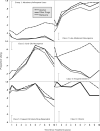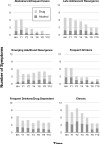Alcohol and drug involvement after adolescent treatment and functioning during emerging adulthood
- PMID: 19926231
- PMCID: PMC2822084
- DOI: 10.1016/j.drugalcdep.2009.10.005
Alcohol and drug involvement after adolescent treatment and functioning during emerging adulthood
Erratum in
- Drug Alcohol Depend. 2011 Jan 15;113(2-3):253-4
Abstract
This study identified patterns of alcohol and other drug (AOD) involvement during the decade following adolescent AOD treatment and developmental outcomes in emerging adulthood. AOD and psychosocial variables were assessed at eight time points from adolescence into adulthood (n=153; 41.2% women) in an inpatient treatment sample of alcohol and other drug dependent teens. Latent class growth analysis identified six trajectories based on alcohol and substance use frequency which were consistent with developmental transitions and validated by measures of dependency symptoms. While few differences were evident at intake, the educational, occupational and interpersonal attainments were differentially associated with the alcohol/drug trajectories as youth transitioned into adulthood. High rates of high school graduation (71.1%), professional occupations (45.2%), marriage/cohabitation (48.5%), and financial responsibility for children (F[5,27]=2.75, p=.02) were evident for those with the least alcohol and drug involvement. More severe drug use trajectories were associated with higher rates of dependence, incarceration and more treatment at the final period of assessment. Outcomes of the trajectory of frequent alcohol involvement were distinct from combined alcohol and drug use. These findings highlight the long-term diversity of substance use outcomes following adolescent treatment and suggest that identification of these patterns of use following treatment can help clarify the developmental impact of youth alcohol and drug use on outcomes in young adulthood.
Published by Elsevier Ireland Ltd.
Figures



References
-
- American Psychiatric Association . Diagnostic and Statistical Manual of Mental Disorders. 3rd ed Author; Washington, DC: 1987.
-
- American Psychiatric Association . Diagnostic and statistical manual of mental disorders. 4th ed. Author; Washington, DC: 1994.
-
- Arnett JJ. Emerging Adulthood. A theory of development from the late teens through the twenties. Am Psychol. 2000;55:469–480. - PubMed
-
- Aseltine RH, Jr., Gore S. Work, postsecondary education, and psychosocial functioning following the transition from high school. J Adolesc Res. 2005;20:615–639.

